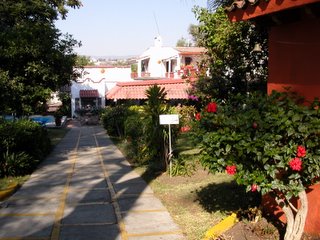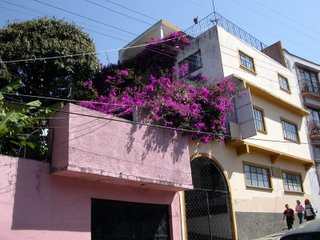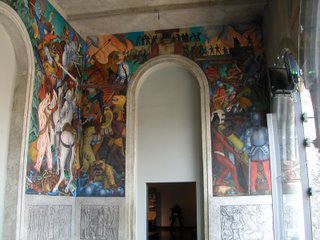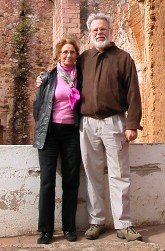
We’re baack (in Querétaro).
I am writing this next to the pool of our hotel, which is in a garden. The hotel is inexpensive, has a single bare bulb on the wall, and no internet or telephones; but it does have TV, and it is in a garden! There is a religious festival at a nearby church and occasionally a cannon, or a super big cherry bomb-plus, goes off which can affect my typing. Happily, the explosions die down by 11:00 PM and don’t start before 8:30 AM. Having a Corona Extra at hand helps, as long as I am not taking a sip when the cannon goes off.
Since the hotel in Queretaro was full for the weekend, we decided to visit Cuernavaca. The trip should have taken 2 hours to the DF (Distrito Federal, Mexico City), a half hour to go around, and an hour to Cuernavaca for a total of 3.5 hours, but . . .
The countryside became greener south of Queretaro and the trees were more than stunted shrubs as had been the case since Oklahoma. We were entering mesoamerica. There were entire hillsides covered in trees as we neared the DF that we did not remember from 30 years ago. That may just be because we could not afford to travel much back then (falta de $$) or it could mean there has been an attempt to stop the denuding of the countryside. In any case, it was a welcome relief from the chichimeca desert area that stretches from around Querétaro to the Great Plains and points north and west.
The trip through the DF actually took 1.5 hours of stop and go traffic in the four lane periferico. This happens so often that in certain areas the street vendors set up shop between lanes of traffic, selling souvenirs and water to the traveling public.
 Cuernavaca
CuernavacaThe trip to Cuernavaca out of the Valley of Mexico and into Morelos made up for it though. Not only was the road in excellent condition (better than anything we saw from Illinois to the DF), but all the chilangos (DFers) were driving like hell to get out of the city so things really moved along (around 80 mph for them, 70 mph for me). The bougainvilla and jacaranda that lined the highway made it seem like a walk in an incredibly colorful garden. Then we hit Cuernavaca.
 Plaza de Armas from the Palacio de Cortes
Plaza de Armas from the Palacio de CortesCuernavaca (a corruption of the Nahuatl name of Cuauhnahuac which the conquistadors had trouble getting their tongues around) is not like we remembered it. When we visited in 1975 or 1976, it was a garden on a hillside. It was clean, springlike, with clear skies, and flowers, flowers, flowers. Now it has clearly seen better days. Pollution is as bad as the DF, and the gardens don’t seem to have the flowers they once had, but instead are made up of various tropical trees and shrubs and vines, but only in varying shades of green. This kind of reminded me of Atlanta when we first visited in 1975, before Atlantans found out there were more types of flowers than azaleas and dogwoods for two weeks in spring. And the hills seem steeper than they did when we were in our 30s.
It is no longer a haven from the hustle and bustle of the DF either. The Plaza de Armas, where we had repaired for lunch, was taken over by a rap concert so loud that you could not hear yourself think for a couple of blocks around it. The waiters in the sidewalk cafes were upset because of the noise and the dwindling clientel; the mariachis had to take refuge under a nearby bridge and looked a little bewildered, as if asking why anyone would prefer rap to real music; and one had to shout to be heard and even then the conversation was incomplete. This probably attracts a certain type of person, but the folks with money tend to go elsewhere.
Luckily we met Miguel at an adjoining table before the “music” started and were able to carry on a conversation during the breaks. He heard us speaking French and said something to Christiane in French. Because of the noise he moved to our table, and we carried on an interesting conversation for the next couple of hours in French, Spanish, and English, and if we had spoken them (which he did) German and Japanese. His adoptive parents were German and Japanese and he worked and studied in both countries, plus the US and France. He does not like Spain, BTW.
The conversation touched on politics in Mexico (the current liberalization from the old oligarchy is an illusion), racism (it is worse in Mexico than in Europe, hard to believe!), unemployment and underemployment (the waiters make $18 a week US and folks with a BA can’t find a job in their specialty), the level of higher education (training for a job versus education for an informed life), and the situation in Cuernavaca where Miguel was born, but only visits now from the DF where he lives and works (like most everyone else).
He said that middle class folks began moving out of Cuernavaca to places like Toluca, Morelia, Puebla and Queretaro when the kidnappings began and things have been going downhill ever since. Kidnappings!?!?!? Coupled with the fact there is no real industry here (Cuernavaca has been a vacation town since before the conquest, and housed Moctezuma, Cortes and Maximillian), Miguel does not see much of a future for Cuernavaca as things stand.
We had not heard of the kidnappings, but we had heard of the influx of narcotraficantes who are buying and building big gated mansions to protect themselves from the kidnappers and other narcotraficantes, presumably, while they enjoy the truly delightful climate of Cuernavaca.
Things are just not like we remembered them. There are still beautiful places, but you need a car to see most of them since they are outside the center of town. Queretaro, a world heritage site, is looking better and better all the time; plus it’s flat.
 Palacio de Cortes
Palacio de Cortes Part of Diego Rivera's Conquest of Cuernavaca in the Palacio de Cortes
Part of Diego Rivera's Conquest of Cuernavaca in the Palacio de CortesWhat’s to see in Cuernavaca? This is where Cortes built his palace starting in 1526 (what was happening in Europe in 1526 only four years after the conquest and only 34 years after Columbus discovered America?). The palace was owned by the Cortes family for about 100 years and then had its ups and downs. It now houses a really nice museum that does not overload you with stuff but has information that I have not found elsewhere on the first year or two of the conquest. It also has one of Diego Rivera’s best murals, on the history of Cuernavaca from its conquest in 1520 or 21 to Zapata, one of my heroes, in the 1910s.
 Barranca Amanalco looking up
Barranca Amanalco looking upOne scene in the mural depicts the difficulty of the conquest of the city presented by the barrancas that protected the east and west sides of the city. Barrancas are nearly vertically sided ravines cut through the volcanic ash from the innumerable eruptions of nearby volcanoes like Popocatepetl (which is getting active again) and Ixtacihuatl, two volcanoes I used to see everyday in Cholula and which are known throughout Mexico. The barrancas around Cuernavaca are as deep as 45 meters (130 feet), and Cortes and his men, with the help of the Tlaxcaltecans, cut trees to fall across the ravines to act as bridges, but even so it was not an easy task. In Cortes’ relaciones to the King of Spain, he noted that there were two ways into Cuernavaca without crossing the barrancas, but at the time he did not know about them so they had a tough time of it and no horses.
 16th Century Cathedral with skull and cross bones over the main entrance.
16th Century Cathedral with skull and cross bones over the main entrance.The cathedral was begun about the same time and looks more like a fortress, which it was, than a Franciscan monastery, which it also was. Murals dating to the 1620s (what was happening in New England in the1620s?) in the cathedral were found in the 1950s beneath layers of other frescoes and paint, and depict the death of the first Mexican saint, San Felipe in 1596. San Felipe was crucified by the Japanese along with several dozen other Franciscans who were trying to evangelize Japan. And to think that Miguel now speaks Japanese.
The quesadillas have arrived. Another Corona, por favor.
 Jardin Bordas
Jardin BordasAfter visiting the 18th century Bordas garden (really something to see and with a unique history) where Maximillian built his palace and dallied with the local Indian ladies prior to his arrest and execution, we had lunch in the imperial house. Later we took a siesta next to an artificial lake where Zapata and his men were photographed in 1910 or thereabouts, sombreros, rifles and all. Christiane probably remembers this visit more because of the art exhibit of Jose Juarez whose paintings reminded us both of her brother Daniel’s early work. Seems Jose studied in France too.
 Lago at Jardin de Bordas
Lago at Jardin de Bordas Restaurant at Hacienda de Cortes
Restaurant at Hacienda de CortesLater we went to Cortes’ hacienda on the edge of town and a couple of barrancas over. This was a sugar plantation on a scale unlike anything I have ever seen on St. Croix or Puerto Rico. Cortes tried to impress the local Indians to do the dirty work, but they refused, and instead he brought in African slaves from the islands. The details on how all this played out must be fascinating, and are something for future research.
 Sugar warehouse at Hacienda de Cortes
Sugar warehouse at Hacienda de CortesToday the ruins are used for banquets and weddings, etc. This weekend Sara from New York (according to our taxi driver) is getting married. Out taxi driver did not have a clue who Sara was, but says that everyone in the vicinity now knows Sara. Not only did he drive her around when she was down looking for places to get married, but he escorted various family members to Xochicalco (an exceptionally important archaeological site) and elsewhere. Seems that Cuernavaca has been conquered yet again.
 Hacienda de Cortes Ruins held together by roots.
Hacienda de Cortes Ruins held together by roots. Hacienda de Cortes Ruins
Hacienda de Cortes RuinsTomorrow, on to Tequisquiapan for a night before returning to Queretaro. Tequisquiapan was recommended to Christiane by the owners of a couple of Mexican restaurants in Atlanta, one in Midtown and one in Decatur. The owners were parents of kids at the Atlanta International School (muy caro $$$$). Tequisquiapan is turning out to be the replacement of Cuernavaca for chilangos. During the week it is pretty calm, but on weekends the influx of folks from the DF causes traffic jams in the little village, and I suspect real estate prices are skyrocketing.
The beer has run out, and it’s time to go read the book we just bought at Sanborns. Sanborns? That’s another story.

No comments:
Post a Comment